
Topics
Seventy-five percent of all winter weather-related deaths occur on the road, either in accidents or by people becoming stranded. When the weather is bad and driving conditions are poor, the best bet is to stay at home.
- Make sure your car is in good running condition. Make sure that your battery, antifreeze, windshield wipers, ignition and thermostat are all in good working order. Be sure your tires have enough tread. Replace any of these items if necessary.
- If you must go out when snow and ice are on the ground, let someone know your destination and when you plan to arrive. Also take a cell phone with you if possible.
- Clean snow and ice off all parts of your car before you drive away.
- Keep your gas tank as full as possible when snow and ice are forecast. This will not only give you added peace of mind, it also increases the weight of your car and this will provide additional traction.
- Keep the following basic items in your car – windshield scraper and brush, booster/jumper cables, a tow chain or rope, bag of sand or salt, blankets, flashlight, first aid kit and road map.
- Drive slower. Driving at even posted speeds is extremely dangerous when snow and ice are on the road. Many vehicles will lose traction, especially at higher speeds, resulting in serious accident and vehicle rollovers.
- If your vehicle loses traction and begins to skid, steer the front tires into the direction of the skid. Never hit your brakes as this will result in a more serious skid and spinning of the vehicle. When your vehicle skids, keep your cool and remain calm. Driving at slower speeds will help you recover from a skid.

All information on this page has been supplied by the National Weather Service.
